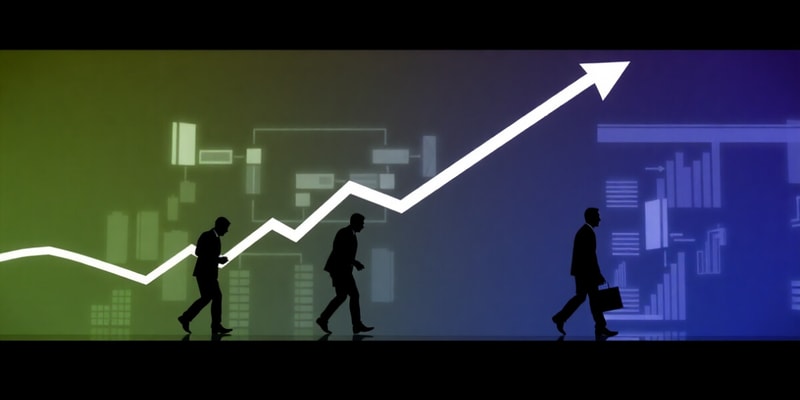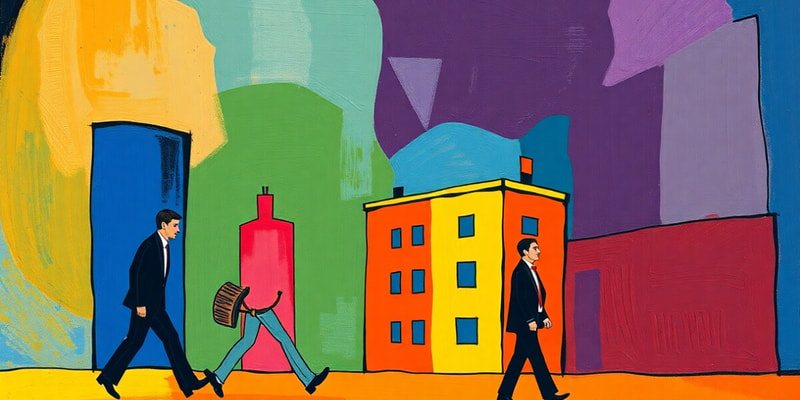Podcast Beta
Questions and Answers
Which phase of the business cycle is characterized by increasing employment and consumer expenditure?
What is the lowest point of the contraction phase called?
Which of the following factors does NOT influence the business cycle?
Which employment scenario was noted as positively correlating with increased living standards?
Signup and view all the answers
What type of unemployment was mentioned but not fully described in the document?
Signup and view all the answers
What characterizes the Peak stage of the business cycle?
Signup and view all the answers
Which economic event is an example of a significant downturn in the economy?
Signup and view all the answers
What does the term 'Trough' refer to in the business cycle?
Signup and view all the answers
In the context of the business cycle, what does 'Expansion' signify?
Signup and view all the answers
Which of the following best describes 'Stability' in the context of economic cycles?
Signup and view all the answers
What is the primary cause of structural unemployment?
Signup and view all the answers
What characterizes fictional unemployment?
Signup and view all the answers
Which factor is mentioned as contributing to unemployment?
Signup and view all the answers
How long is the temporary unemployment period expected to last according to the diagram?
Signup and view all the answers
What steps are involved in the flow of events regarding job transition?
Signup and view all the answers
What characterizes the expansion stage of the business cycle?
Signup and view all the answers
Which stage of the business cycle marks the lowest point in economic activity?
Signup and view all the answers
What is typically a consequence during the contraction phase of the business cycle?
Signup and view all the answers
What does overheating in an economy primarily signify?
Signup and view all the answers
Which factor is NOT mentioned as influencing the business cycle?
Signup and view all the answers
What defines leading indicators in economics?
Signup and view all the answers
Which of the following is an example of a lagging indicator?
Signup and view all the answers
How are leading indicators typically useful in economic analysis?
Signup and view all the answers
What is a characteristic of lagging indicators?
Signup and view all the answers
Which of the following statements is true regarding leading and lagging indicators?
Signup and view all the answers
What is an example of concurrent economic indicators?
Signup and view all the answers
What leads to economic expansion in terms of effective demand?
Signup and view all the answers
Which factor can be categorized as an external influence on effective demand?
Signup and view all the answers
What characterizes decreased aggregate demand?
Signup and view all the answers
Who is a key figure associated with the concepts related to economic indicators and demand fluctuations?
Signup and view all the answers
How do monetary policy decisions typically impact the economy?
Signup and view all the answers
What role does government policy play in economic development?
Signup and view all the answers
What is the relationship between investment and output in economics?
Signup and view all the answers
Which macroeconomic factor is often analyzed alongside prices and employment?
Signup and view all the answers
Which area is least likely to be influenced by macroeconomic factors?
Signup and view all the answers
What is primarily affected during the contraction phase in terms of employment?
Signup and view all the answers
Which factor is NOT associated with the contraction phase?
Signup and view all the answers
What is a characteristic of the trough and depression phases?
Signup and view all the answers
How does COVID-19 impact the economic cycle according to the analysis?
Signup and view all the answers
What happens to input prices during the contraction phase?
Signup and view all the answers
What does the phrase 'difficult to control' likely refer to?
Signup and view all the answers
What can be inferred about the national income during a recession?
Signup and view all the answers
What is an impact of lower wages during the contraction phase?
Signup and view all the answers
Study Notes
The Business Cycle
- The business cycle refers to the cyclical fluctuations in an economy over time.
- Characterized by periods of expansion and contraction.
- Expansion: Characterized by increasing employment, capital investment, sales, and profits.
- Peak: The highest point of the expansion phase.
- Contraction: Characterized by decreasing employment, reduced capital investment, declining sales, and profits. Consumer spending decreases along with stock prices and bank credit availability.
- Trough: The lowest point of the contraction phase.
Unemployment
- The document correlates a shift from a low-paying job to a higher paying job with an increase in living standards.
- The document notes an increase in income/employment as a possible outcome of the higher-paying job, with a mention of a decrease in unemployment.
- Mentions different types of unemployment ("structural unemployment").
Types of Unemployment
- Structural Unemployment: Caused by outdated techniques and/or lack of skills. A shift in the demand for labor has occurred.
- Fictional Unemployment (Temporary Unemployment): Arises when people who are currently employed switch jobs.
Contributing Factors to Unemployment
- Technology: Handwritten notes mention computer technology as a contributing factor to unemployment.
- Age: The notes mention the issue of workers being outdated in their skills or having old techniques.
Business Cycle Stages
- Prosperity/Boom: High economic growth and increasing investments.
- Peak: Highest point of the cycle, where growth slows or stops.
- Recession/Contraction: Period of decline in economic activity, characterized by decreasing investments.
- Trough: Lowest point of the cycle, where a trough in economic activity occurs.
- Expansion: Period of economic growth following a trough.
Factors Influencing the Business Cycle
- Growth (↑): An upward trend in economic activities.
- Stability: Consistent economic performance without significant fluctuation.
- Condition: A general description of the economic status.
- Trend and time: The trajectory and duration of the economic cycle.
- Who buys and for whom? Questions regarding the consumption of produced goods.
- Rich and Haves: Mentioning factors that may contribute to economic activity.
- Upswings and Recovery: Indicates positive changes in economic activity.
- Downturns in the Economy: Refers to depressions or recessions.
Notes on Business Cycle
- The business cycle is characterized by fluctuations in an economy's output, employment, and prices.
- Expansion: Characterized by higher GDP, employment, and inflation.
- Peak: A temporary high point in the business cycle.
- Contraction: A downward part of the cycle, marked by reduced economic activity.
- Trough: A temporary low point in the business cycle. Demand stagnates during this stage.
- Overheating: The economy becomes unstable or unsustainable, characterized by inflation.
Factors Influencing the Business Cycle
- Increased Input Prices: Raw materials, wages.
- Increased Output Prices: Sales prices.
- Cost of living: Increased rent, electricity, and water bills.
- Demand: Actual demand may reach a temporary "stagnation" point.
Economic Cycle Analysis
- Contraction Phase (Recessions): Reductions in investments lead to a decline in employment, lower wages and interest rates, a decline in aggregate demand, lower input prices, a drop in expected prices, a shock to bank credit, and a decrease in national income.
- Trough & Depression: Effects on national income. Impact of the pandemic on various economic factors (marked by the "covid 19" label and dates). A peak that doesn't encompass the entire nation or region. Recessionary periods or contractions. A period of economic decline. The overall cycle of economic ups and downs.
- Diagram: The handwritten document possibly shows a circular flow arrow diagram indicating cause-and-effect relationships among factors like aggregate demand, prices, bank credit, and national income.
- Important Dates: - Feb 2020: Possible start of economic shifts leading to the contraction. - Aug 2020: Another key date for economic analysis, possibly related to COVID-19 effects.
Types of Economic Indicators
- Leading Indicators: Occur before an economic change. Examples: Stock Price, Profit Margins, Profit Indexes, Housing Interest rate.
- Lagging Indicators: Occur after an economic event. Examples: Unemployment, Corporate Profit, Interest rates, Consumer Price Index.
- Concurrent (Simultaneous): Economic indicators can occur together. Examples: Personal disposable income, retail sales.
Causes & Fluctuations in Effective Demand
- Internal/Endogenous: Factors within the system cause fluctuations in effective demand.
- External/Exogenous: Factors outside the system also influence effective demand.
- Spending Money: When companies have jobs to complete and generate profits, they will spend money, driving demand.
- Effective Demand Expansion/Contraction: An increase in effective demand leads to economic expansion, while a decrease leads to contraction.
Investment Fluctuations (Entrepreneurs)
- Increased Aggregate Demand: Economic expansion.
- Decreased Aggregate Demand: Economic contraction.
Key Figures (Related to this topic):
- Lord JM Keynes (1936)
Notes on Economics
- Development: Various concepts related to economic development.
- Macroeconomic factors: Examined prices, employment, and output relationships.
- Monetary policy: Discussions include interest rates, money supply, and their effects on various aspects of the economy.
- Investment: This component's connection to output is highlighted.
- Tax and policy: Government policies' roles are noted.
Studying That Suits You
Use AI to generate personalized quizzes and flashcards to suit your learning preferences.
Description
Explore the intricacies of the business cycle and its relationship with unemployment. This quiz covers key phases of the business cycle, including expansion, peak, contraction, and trough, as well as various types of unemployment. Test your understanding of economic fluctuations and their impact on employment levels.




